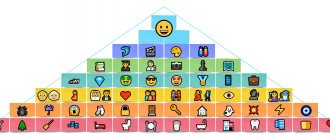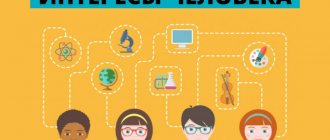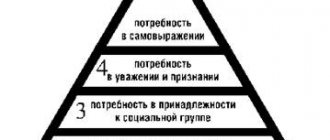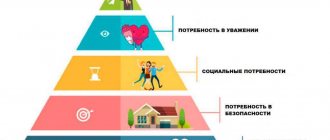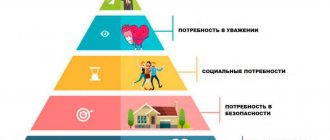Application in life
As we said above, theory helps you understand yourself - thoughts, desires, values and fears. By analyzing events or actions, you can understand what need needs to be satisfied and what factors prevent this from being done.
A person is also able to analyze other people and understand how to interact with them. This could be supporting a friend or partner in difficult times, observing ethics in business communication, or expressing gratitude to a salesperson in a store.
comparison table
The main features and differences of the concepts under consideration are given in the table:
| Criterion | Need | Need |
| Scope of terms | It is considered a fairly broad concept, and need is part of it. | On Maslow's pyramid of needs, only the bottom 2 steps are allocated for needs. |
| Significance | It represents goods without which human life is difficult, but possible. | It appears in the form of a primary object, which cannot be avoided. |
| Appearance | It is subjective in nature and appears in the human consciousness. | Differs in objective existence. The presence is due to human nature itself. |
| Relativity | They happen exclusively to people – creatures with highly organized consciousness. | They occur in any living creature - both people and animals. |
Maslow's pyramid of needs A.H.
Primary Needs
- Physiological (satisfaction of natural instincts, these are: thirst, hunger, rest, reproduction, breathing, clothing, housing, physical activity)
- Existential (from Latin existence, this is the need for protection, security, confidence in the future, insurance, comfort, job security)
- Social (the need to live in society, to belong to a certain social group: communication, affection, attention to oneself, caring for others, participation in joint activities)
- Prestigious (the need for respect, recognition, career growth. It is no coincidence that A. Maslow singled out prestigious as a special type of needs, since the opinion of society and others is very important to a person. Any praise is pleasant to people, there is a desire to do something even better.
- Spiritual (self-expression, self-realization through creativity, knowledge, teaching, self-affirmation, etc.)
Human needs have a number of features:
- all needs are interconnected
- it is impossible to satisfy all needs
- limitlessness of needs
- needs should not contradict the moral principles of society.
A person changes - some of his needs become different. Even in a single society, at a certain stage of development, there may be its own needs. Needs are determined by both the natural and social essence of a person.
Yes, human activity and actions are driven by the desire to satisfy their needs. It is important to set priorities for yourself, to clearly know what a person wants and why he needs it. And we must not forget that a person’s needs are limitless; it will not be enough to satisfy everything 100% throughout one’s life. So the choice depends on everyone, on the level of his upbringing, development, on the environment in which he lives, on those values that are important for his environment. It is important that the needs are genuine, guys, do not allow imaginary needs to take over your soul and consciousness. Live enjoying life, giving joy to your loved ones.
Material prepared by: Melnikova Vera Aleksandrovna
Classification of human needs
In psychology, all human needs are usually divided into three groups. This classification is quite unambiguous, since each group has very specific and obvious criteria. Let's look at each of them in detail.
Biological needs
This category includes basic needs aimed at survival, achieving physical comfort and procreation. It includes:
- delicious food (taste is important to determine freshness and nutritional value);
- clean water to quench thirst;
- comfortable living conditions;
- security and confidence in your future;
- satisfaction of sexual needs.
The listed aspirations are present in all living beings. They were formed evolutionarily to ensure the survival of the population. Essentially, they are all mechanisms that allow a person (or other creature) to survive and achieve “reproductive success” (produce offspring and ensure their survival in the future).
Social needs
Since man is a social being, he has a number of instinctive aspirations aimed at increasing his own importance in society or his group. The most illustrative examples are:
- Self-identification.
A person associates himself with his social group, while striving to recognize himself as an individual with special personal and other qualities. - Self-affirmation.
It is important for any person to be proud of their own actions and achievements, as well as to feel respect from others. - Altruism and passionarity.
Most of us derive pleasure from doing things that benefit other people or society as a whole. At the same time, self-esteem grows even if our contribution goes unnoticed by others, since for an altruist the act itself is important, and not the approval of others.
Spiritual Needs
There is a system of universal spiritual values that most people share in one way or another. We strive for moral and spiritual growth, appreciate beauty, grace of form and harmony, enjoy contemplating objects of art and listening to beautiful music. At the same time, each person has his own taste, so we all like different styles in music and styles in painting. In addition, priorities of spiritual values change throughout life.
Spiritual needs include:
- Self-actualization.
Obtaining new knowledge, expanding the range of interests and hobbies, professional growth, advanced training - these are all natural aspirations for a person who is currently not concerned with satisfying basic biological needs. - Self improvement.
As we grow up, we understand that we like to become better not in order to please someone, but simply to feel our progress. We give up smoking and alcohol, take up sports, begin to maintain a daily routine and control our stress levels. We just like to think that we're getting a little better every day. - Romantic love.
This point could be considered a manifestation of the reproductive instinct, but for us it is something much more. It is very important for us to have a loved one nearby who inspires us and gives us not only sexual but also emotional pleasure.
Spiritual needs, unlike biological and social ones, are present only in humans. Moreover, their list is not just extensive, but almost endless, since each person finds some of his own hobbies that do not have to be shared with someone else. Some people like fishing, some prefer knitting, some watch TV series, some reread The Little Prince for the hundredth time, some adore the sound of pouring rain outside the window, and some experience peace from the echoing the croaking of frogs in a nearby pond.
Let's look at examples of test tasks
with theory , now it's time to start practicing . Start completing the first sample task yourself, and then check your answers.
Correct answer: №1
Correct answer: №3
Correct answer: №1
Post Views:885
Post tags Post tags Social studies Unified State Exam
Basic human needs
Basic needs represent everything without which a person cannot exist. And we are not talking about “increased comfort” at all. Primarily physiological aspects are implied. They vary depending on the individual's personality and temperament.
For example, if we talk about the need to eat food, you can notice: for a normal life, someone needs to “constantly chew something,” while someone gets full from a few spoons of salad. This is normal.
With the development of the population, basic needs began to include not only biological, but also such aspects as wearing clothes and shoes. Individuals may include the need to be alone with themselves in order to calm down, find harmony with the world and restore strength. For some, the “base” is communication. But there are also those for whom daily training (sports) or certain other activities are extremely important. Without them, a person begins to feel unwell on a physical level.
Important: from the above it follows that individuals have the opportunity to have an individual set of basic needs. But they all necessarily include “physiology”.
What needs does a person have?
Man is one of the representatives of the animal world, with instincts and needs inherent in other species. At the same time, we have higher intelligence, feelings, and strong-willed qualities. This combination causes the presence of needs at two levels: basic and additional (primary and secondary).
Basic Needs
This group is vital for humans as a biological species. Basic needs are divided into two groups.
| Physiological | Existential |
| Breathing, nutrition, thirst, sleep, rest, procreation, housing. | Comfort, social and legal security, availability of employment, etc. |
Physiological basic needs must be satisfied first, since without them existence itself is impossible. The listed things and phenomena have been inherent in man since primitive times.
A person tries to make the process of satisfying basic needs more comfortable. If at the initial stage of the development of the human race animal skins served as clothing, today a whole industry is working to clothe us.
Basic needs can change with age in favor of the predominance of some over others. Sleep, for example, is more important for young children and older people, but in our youth we are able to get by with minimal hours of rest and still feel alert. Sex, as a primary need, can also, for a number of reasons, lose priority with age, but in adolescence it is a priority.
Questions often arise about security as a necessity for existence. Man has always experienced danger from phenomena in the surrounding world or from other people. A tsunami, a collapse of glaciers, an attack by wild animals or other tribes - all this forced a person to defend himself or run away. Over time, entire institutions were formed that were supposed to protect the individual from external incursions (army, police, Ministry of Emergency Situations). That is why safety is a primary need; we must understand that our lives and property are protected and protected.
The needs of existence (existence) appear as an individual grows up and determines his place in society.
Secondary needs
If a group of primary needs is necessary for survival and is laid down at the genetic level, then secondary needs determine a certain level of a person’s quality of life and come and are transformed with life experience.
Among the secondary needs in theory, the following are identified:
- Spiritual
. These include the need to obtain new knowledge about the world, the search for the meaning of life and one’s place in it, the development of creative abilities, and the desire for harmony. - Social
– love, friendship, interaction with other people, feeling part of society, a separate social group (class, work team, family). - Prestigious
. We are talking about the need for recognition of our successes, worthy self-esteem, respect from other members of the communities in which we belong.
Thus, primary needs are innate and determined by physiology, while secondary needs are psychological in nature and develop throughout life.
What are needs?
Need is an internal feeling of need for certain resources, circumstances or actions. Of the entire animal world, humans have the widest range of needs: from mundane physiological to sublime spiritual. Needs include all material and intangible resources, actions, circumstances and other factors necessary for a person to feel satisfied or happy.
Human needs
appear as follows:
- An unmet need is usually associated with a feeling of discomfort, anxiety, melancholy and other negative emotions.
- Satisfaction of a need is accompanied by positive emotions (both directly at the moment of its satisfaction, and when realizing that it has already been satisfied).
- There is a fixation on the subject of need. A person’s attention involuntarily concentrates on what he lacks. When we get hungry, we begin to more sensitively detect appetizing smells, and a lonely person in any circumstances looks for reasons to meet a potential “soul mate.”
Also, human needs are characterized by the following features:
- people need much more to achieve a state of satisfaction than other species;
- with age, the number of needs increases, their priorities change (a child needs much less to be happy than an adult, and for older people social and spiritual values become much more important);
- there is a completely unambiguous hierarchy of needs, and those that are of great importance can “drown out” the less important ones.
Needs are the most important motivator that forces us to act and move forward. The most basic of them force us to work to ensure our existence, and the higher ones stimulate us to development, improvement and self-actualization. All existing achievements of mankind, including inventions, scientific theories, objects of art, musical and literary works, were created under the influence of human needs.
Types of needs
There are several classifications of needs. According to the most common types of needs, the following types of needs are distinguished:
| Types of needs | Examples |
| biological, that is, natural, innate, natural | food, air, sleep, reproduction, etc. |
| material | housing, clothing, jewelry, etc. |
| social | communication, society's assessment of human activity, labor. |
| spiritual (cognitive, cultural, ideal) | teaching, formation of a worldview, knowledge of the world, society and oneself, search for an ideal, the meaning of life, moral values, etc. |
American psychologist A. Maslow built needs in the form of a kind of pyramid: the closer the need is to the base of the pyramid, the more necessary it is. All subsequent ones are needed when the previous ones are satisfied.
Ideal Needs
Only humans have ideal needs.
They arose relatively recently. For example, Aristotle included the “desire for knowledge” among the ideal needs that distinguish humans from animals. It must be distinguished from the need for information, which manifests itself in animals in exploratory behavior. Even a laboratory rat, living in the same cage for several months, periodically walks around all the walls, intensely moving its whiskers. It is human nature to try to comprehend the cause of things, and not just the laws of the surrounding world. For example, a domestic cat tries to get food. Empirically, she quickly establishes that in order to satisfy her nutritional needs, she must rub her forehead against the leg of the person living with her. But where does fish come from, and especially boiled fish, the cat is not concerned with such questions. Since the need for knowledge is not found in all people, sometimes the needs that distinguish a person from an animal include the need not for knowledge, but for self-knowledge: as Chilon of Laconia said, “know yourself.”
In the remaining needs, which are usually classified as ideal, as a rule, it is possible to identify components that are other needs. For example, the need for religion is determined, in particular, by the need for social self-identification, that is, to belong to a certain limited community of people, which differs from other human communities in a number of external characteristics. In addition, in religious feelings there is also the realization of the need to submit to the leader, who is responsible for everything that happens:
Atheists are forced to admit that all the troubles that happen to them are their own fault. At the very least, a person is an accomplice in the overwhelming number of incidents that bring him grief. It is not evil people, not a fatal coincidence of circumstances and, of course, not God’s providence that are to blame for a person’s troubles and misfortunes, but only himself. This conclusion is not easy to accept. Therefore, a variety of worldview systems are constantly emerging and will continue to emerge, performing the main function of religion - transferring a person’s responsibility for his life to external circumstances.
Ideal sometimes also includes needs that do not increase the viability of the individual itself or the community to which it belongs. In particular, informational and social needs are considered ideal if they dominate over the needs of self-preservation.
Needs can rise and expand
As we see, at the base of the pyramid of needs are those needs without which a person cannot survive. And at the very top is the need for self-expression, which not even every person experiences and not at every moment of time.
This is one of the key ideas of the pyramid of needs: a person is most often inclined to “elevate” needs . That is, when lower needs are satisfied, a person develops needs at the next level. Then the next one, and so on.
For example, a hungry and cold person needs food and warmth and cannot enjoy beautiful music or deep literature. However, when he eats and warms up, he will have a desire to both listen to music and read a book.
Now consider the concept of “expansion” of needs. This means that people have more and more different ways to satisfy the same needs.
For example, once a person was content with a very limited set of food products: caught fish and game, collected fruits. And now we not only bring products from all over the world for a varied diet, but also prepare the most delicious dishes from them.
Scientific theories about human needs
Abraham Maslow's theory
This is the most famous classification of human needs, everyone who has at least once been interested in self-development knows about it. This concept was proposed and developed by the American psychologist Abraham Maslow in a number of his works on motivation. He sorted all human needs by elevation: from lower (biological) to higher (spiritual). Due to the characteristic form of the schematic image, this classification was called “Maslow’s Pyramid”.
The author himself identified 5 levels in his classification:
1. Physiological needs.
In this group he included food, water, sleep, sexual satisfaction - all the basic needs of our body.
2. Safety.
When all physiological needs are satisfied, a person seeks to protect himself and his family. This group includes not only good protection from predators and other dangers, but also confidence in stability and order.
3. Love and belonging.
Here we are talking about good relationships, love, friendship, belonging to a certain social group.
4. Respect and recognition.
If a person is confident in his own well-being in all areas included in the first three levels of the pyramid, he has a strong need for respect and recognition. Here we are not talking about the banal “You respect me, no?!”, but about real respect for actions and achievements.
5. Self-actualization.
Abraham Maslow included in this group self-development, self-education and other ways of working on oneself, one’s skills, knowledge and abilities.
If you look closely at the 5 tiers of Maslow’s pyramid, you will notice that the first two are biological, the third and fourth are social and partially spiritual, and the fifth are purely spiritual needs.
One of the most important statements of Maslow's theory is that each level becomes important only if all the needs located at lower levels are fully satisfied. For example, hunger or unfulfilled sexual instinct (first level) makes a person forget about caution and safety (second level).
If we compare lower needs with higher ones, we can notice several characteristic differences:
- higher needs appear much later (they first appear in adolescence, after which they develop throughout life);
- higher needs are perceived by most people as less important, “optional”;
- the higher the need is in the hierarchy, the easier it is to postpone its implementation to the future in order to solve more pressing problems;
- people living at higher levels of Maslow's pyramid tend to have good health (partly because they take care of it), experience less stress and sleep better;
- a person receives much more joy and pleasure from satisfying higher needs.
The original concept proposed by Abraham Maslow had 5 tiers, which we discussed above. Later, many authors took liberties in its interpretation and introduced additions, increasing the number of levels. Therefore, do not be surprised if you see different variations of the pyramid with 7 or 10 tiers. In any case, the basic concept of Maslow's theory remains.
Read more about Maslow's Pyramid of Needs in this article.
Alderfer's ERG theory
American professor Clayton Alderfer proposed an alternative theory of motivation. It does not contradict Maslow’s theory, but it uses its own classification of needs, which includes 3 groups (the abbreviation ERG is derived from their names):
- Existence (existence, life).
- Relatedness (relationships, communication).
- Growth (personal growth, development).
As you might guess, the first group is represented by physiological needs, the second by social, and the third by spiritual. At the same time, Clayton Alderfer showed that the relationship between these groups is somewhat more complex than Maslow described (priorities are influenced not only by the fact of satisfaction itself, but also by the degree of satisfaction).
In addition, he noticed that dissatisfaction with higher needs increases the desire to satisfy lower ones. For example, it is known that during any crisis the revenue of confectionery stores increases sharply. This is explained by the fact that people, losing a sense of stability, begin to buy more sweets (even those who do not like them at all and usually do not buy them).
Fromm's theory
German psychologist and sociologist Erich Fromm considered social interaction to be a key factor influencing the human psyche. This was reflected in his theory of needs. He proposed a five-point hierarchical scheme:
- Interpersonal connections (love, friendship).
- Creativity (any creative activity, regardless of type).
- Feeling of strong and deep roots (stability).
- Search for the ideal and assimilation to it (self-improvement).
- Knowledge of the world (spiritual improvement).
As one of the founders of neo-Freudianism, Fromm believed that our basic needs are controlled by the unconscious. But since the unconscious often encounters such obstacles as taboos, stereotypes, logic, rationality, etc., needs remain unfulfilled.
McClelland's theory of acquired needs
American writer and psychologist David McClelland proposed his theory of motivation. He believed that all needs are formed in childhood. At the same time, he divided them into three groups, explaining the mechanism of formation of each of them:
- Involvement.
This need arises in children who were engaged in collective activities and played team games. As a result, even in adulthood, they feel the need to be part of a group, to participate in a socially significant project or movement. - Power.
If in childhood one way or another is encouraged to control other children, in adulthood such a person needs a sense of power. Also, this need can be formed under the influence of the family atmosphere. - Success.
If a child is taught to be independent, to achieve something, to receive prizes and certificates, as an adult he will also need success.
How Maslow's pyramid is used in marketing
In marketing, Maslow's pyramid is used to analyze the market and segment the audience according to hierarchy. This helps to find out which needs are the strongest for your target audience.
Then you need to explore how the audience sees the specific need being met. And when you already know what your potential clients are looking for, you can offer them a suitable solution.
Imagine a fast food restaurant. His audience is people who want to eat quickly. They don’t have time to wait for a long time for an order; they don’t choose a restaurant based on how cool it is. The audience has a physiological need to satisfy their hunger, preferably quickly and tasty. And this is exactly what the restaurant focuses on when advertising. Examples of slogans: “Eat and drink here 24 hours”, “The best food for a quick snack”, “Large portions, low prices”.
If the goal of marketing is to promote a product, you can focus on what need it satisfies.
The pyramid can also be useful for long-term planning. For example, you can explore the degree to which the audience’s needs are met and track the dynamics of change. As a result, future demand can be predicted in order to develop and bring to market products that are relevant to customers.
Part of Maslow's theory in marketing is understanding customers' wants, needs, goals and motivations. Having determined the client’s level in the pyramid, you can develop the most advantageous offer for him. You can analyze the current needs of your audience in order to offer suitable products.
However, Maslow’s pyramid should not be taken as an accurate marketing tool. Needs theory is more of a line of thought. People really do have a certain hierarchy of needs. But at the same time, the pyramid may be absolutely inapplicable to an individual person or group of people. A person's higher needs can prevail over lower ones for various reasons.
In marketing, Maslow's pyramid is best used only as an auxiliary method. To actually solve specific problems, it is better to use precise tools.
Concept of need
This term is understood as the need to satisfy the material or spiritual needs of people. This concept includes a wide range of desires. It starts from physiology and ends with spirituality. At the same time, needs are subjective and depend on the individual. During life they constantly develop and are time-bound.
From a marketing point of view, a need is a need that takes a special form, taking into account the level of culture and personality of a person. As society develops, so do the needs of its members. At the same time, people constantly encounter objects that arouse their desire, interest, and curiosity. This is used by manufacturers who take a number of actions to stimulate people’s desire to own certain goods.
Biological needs
Man is a creation of nature. Therefore, the basis of its activity is the satisfaction of biological needs. In another way they are called physiological, natural, organic. They are given to us from birth. If ignored, the human body may stop functioning normally. Let's look at examples of such needs.
- In order for our body to fully develop, it needs a balanced diet. Wrong food choices can lead to various types of diseases (obesity, diabetes, musculoskeletal disorders).
- Equally important is the need for sleep. Each body has its own rate of rest. If the body does not rest fully, malfunctions in the functioning of the most important vital systems may begin.
- In order for the body not to undergo premature aging, people need to move. Sedentary work leads to poor posture, obesity, and joint diseases. To avoid this, you need to walk more often, do gymnastic exercises, and do exercises.
- The list of biological needs includes the need for clean water. It helps eliminate harmful substances and nourishes the body's cells. Excessive consumption of sweet carbonated drinks negatively affects the digestive system.
- The need to breathe is inherent in all people by nature. Clean air, saturated with oxygen, improves brain activity and improves the quality of life.
Rice.
2. Jogging. A person can live only a few minutes without air, without water - about a week, without food - a little more than a month. Lack of sleep for 5-6 days leads to sad consequences: mental disorders, hallucinations, death.
How did the image of the pyramid of needs come about?
The theory of needs was developed by Abraham Maslow, but he was not involved in the creation of the pyramid. There was not a single graph in the psychologist’s work.
It is believed that the first graphic representation of the hierarchy of needs was published in 1975 - in the textbook by W. Stopp. Since then, the scheme has been used inextricably with Maslow’s theory. That’s what they call it: Maslow’s pyramid or pyramid of needs.
The pyramid is often depicted in the shape of a triangle. The lowest wide part covers basic needs, then the following levels are displayed towards the top:
- Physiology (hunger, thirst and other natural needs).
- Security (feeling of security, lack of fear).
- Belonging and love.
- Respect and recognition (fame, success, prestigious status).
- Cognition (gaining knowledge, skills and abilities).
- Aesthetics (striving for beauty, searching for ideals).
- Self-actualization (realization of abilities and desires).
Schematic representation of Maslow's pyramid
In 2010, a group of scientists from the USA and Canada updated the pyramid taking into account modern realities. In their opinion, basic needs remained the same. In the same way, people need food, security, belonging and love. As for the upper levels, reproductive goals come to the fore: maintaining relationships, finding a suitable partner and raising children. Self-actualization is combined with recognition. At the same time, scientists note that needs sometimes shift and are interchanged.
Updated pyramid of needs
However, Maslow himself did not rule out deviations from the hierarchy. Some people may stop at the lowest level, others are more in need of self-actualization than security or recognition. Maslow considered such exceptions to be features of a person’s personality or a consequence of unfavorable external circumstances.
The hierarchy of needs remains popular in psychology, within the framework of sociology research, and in management training. However, Maslow's pyramid is often criticized and called outdated.
Criticism
The criticism of Maslow's pyramid comes down to the fact that it is extremely difficult to apply this model in practice. For example, if a person is not able to meet the basic needs of food and a comfortable place to live, this does not mean that he does not strive to realize his talents. Also, not every person seeks recognition in society - for some, a stable job and starting a family are enough.
There are many examples in history when people achieved success in life precisely because their basic needs remained unsatisfied. Thus, living in poverty can force a person to seek acceptance in society, bypassing the needs of security and belonging. And unrequited love can become an incentive to create magnificent works of art. For example, Van Gogh's passion for painting is attributed to failures in love.
The theory is criticized because of its hierarchy and the impossibility of fully satisfying needs. For example, physiological processes will always be relevant - a person constantly needs to drink, eat, and sleep. For some people, only part of the needs may be important.
The fact that over time Maslow completely revised his own theory is often cited in favor of criticism. In later work, he changed the motivational concept and abandoned the multi-level system.
In the new version, Maslow divided human needs into two types:
- “Scarce” (inferior). These are needs caused by a shortage of something and, accordingly, saturated.
- "Existential" (highest). This type of need is dictated by growth and development and is therefore insatiable.
Like the previous theory about the hierarchy of needs, the new vision was presented by the psychologist in the format of an assumption. The author hoped to find confirmation in the future, but did not have time.
The pyramid of needs should not be taken as an unshakable truth. This is not a strict classification of human needs, but an attempt to determine the more and less significant of them. Basic needs will dominate for most people. But different people may have different motivation systems, and for some, higher-level needs will be more important. By the way, according to Maslow, only 2% of people reach the level of self-actualization.
It turns out that Maslow’s pyramid still makes sense, but it does not need to be interpreted literally. For example, in marketing, the pyramid of needs is actively used when developing a sales strategy. The general principle of the theory is interpreted as follows: it is important to monitor trends in needs and direct efforts to satisfy more pressing ones.
Relationship between biological needs and the needs of other species
What distinguishes humans from other living beings is the ability to take biological needs under control. For example, when experiencing hunger, people are able to wait for food; Needing sleep, a person gets home and goes to bed.
Without satisfying the body's needs, the needs of other groups are relegated to the background. For example, if a student has not eaten for a long time, he is unlikely to be able to learn the material studied in class.
Rice. 3. Schoolchildren in the classroom.
Ignoring the demands of the body has a negative impact on social needs: a hungry person can become aggressive in communication, violate norms of behavior, and perform poorly at work.


